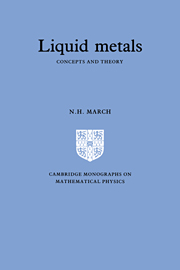Book contents
- Frontmatter
- Contents
- Preface
- 1 Outline
- 2 Pair correlation function and structure factor of ions
- 3 Thermodynamics
- 4 Electron screening and effective ion-ion interactions
- 5 Interionic forces and structural theories
- 6 Statistical mechanics of inhomogeneous systems and freezing theory
- 7 Electronic and atomic transport
- 8 Hydrodynamic limits of correlation functions and neutron scattering
- 9 Critical behaviour
- 10 Electron states, including critical region
- 11 Magnetism of normal and especially of expanded liquid metals
- 12 Liquid-vapour surface
- 13 Binary liquid-metal alloys
- 14 Two-component theory of pure liquid metals
- 15 Shock-wave studies
- 16 Liquid hydrogen plasmas and constitution of Jupiter
- Appendices
- References
- Index
9 - Critical behaviour
Published online by Cambridge University Press: 19 January 2010
- Frontmatter
- Contents
- Preface
- 1 Outline
- 2 Pair correlation function and structure factor of ions
- 3 Thermodynamics
- 4 Electron screening and effective ion-ion interactions
- 5 Interionic forces and structural theories
- 6 Statistical mechanics of inhomogeneous systems and freezing theory
- 7 Electronic and atomic transport
- 8 Hydrodynamic limits of correlation functions and neutron scattering
- 9 Critical behaviour
- 10 Electron states, including critical region
- 11 Magnetism of normal and especially of expanded liquid metals
- 12 Liquid-vapour surface
- 13 Binary liquid-metal alloys
- 14 Two-component theory of pure liquid metals
- 15 Shock-wave studies
- 16 Liquid hydrogen plasmas and constitution of Jupiter
- Appendices
- References
- Index
Summary
In this chapter, an introduction will first be given to some progress in characterizing critical behaviour in terms of critical exponents. This will then be illustrated by calculations based on model equations of state. These will, in fact, give a route to the calculation of the liquid-vapour coexistence curves of liquid metals. Then some other nonuniversal properties, and especially the critical constants of the fluid alkalis, will be considered in relation to simple plasma models. Reference will also be made to spinodal curves.
In Chapter 6, when dealing with freezing theory, the order parameters were referred to; these were, in fact, the Fourier components of the periodic density in the crystalline phase. Again, in the treatment of the liquid-vapour critical behaviour, the concept of the order parameter is basic: Let us take this as a starting point.
Concept of order parameter
In the liquid-gas system, to be treated in detail below, the transition is from the high-temperature (or low-pressure) gas phase to the liquid phase, which has, as discussed quantitatively in the previous chapters, marked shortrange order that is absent in the gaseous phase. Further lowering of temperature or increase of pressure normally produces a further transition to the solid phase, having crystalline long-range order (see Chapter 16). A typical phase diagram is shown in Figure 9.1. Having used the variables T and P, the third variable V is dependent, of course, and could have been used to distinguish the phases.
- Type
- Chapter
- Information
- Liquid MetalsConcepts and Theory, pp. 103 - 120Publisher: Cambridge University PressPrint publication year: 1990



